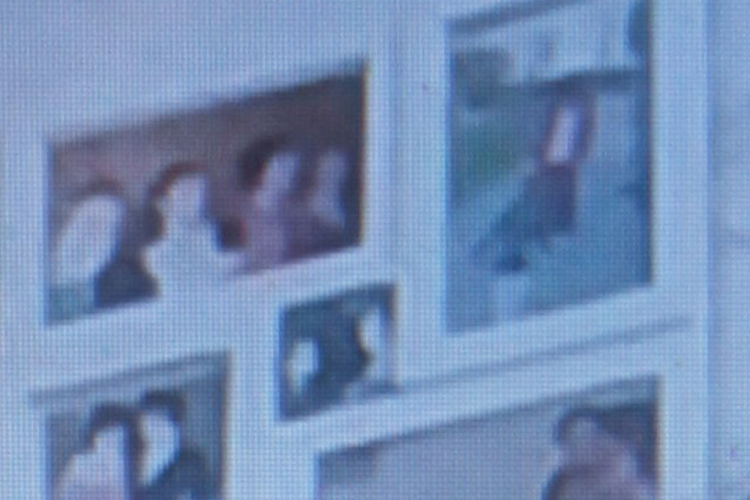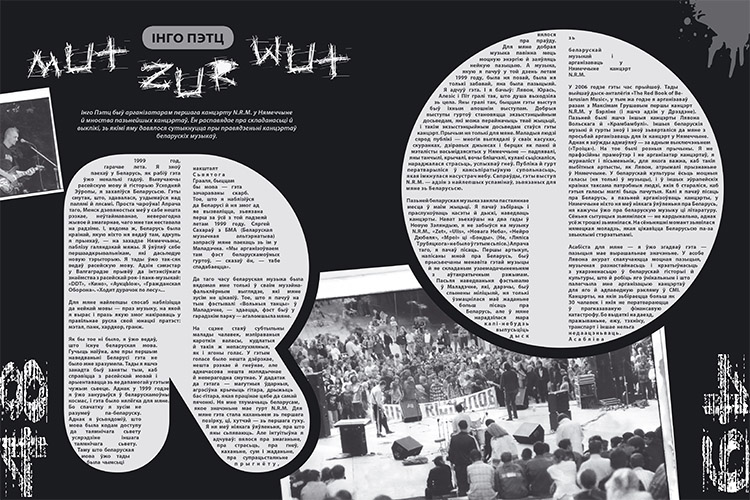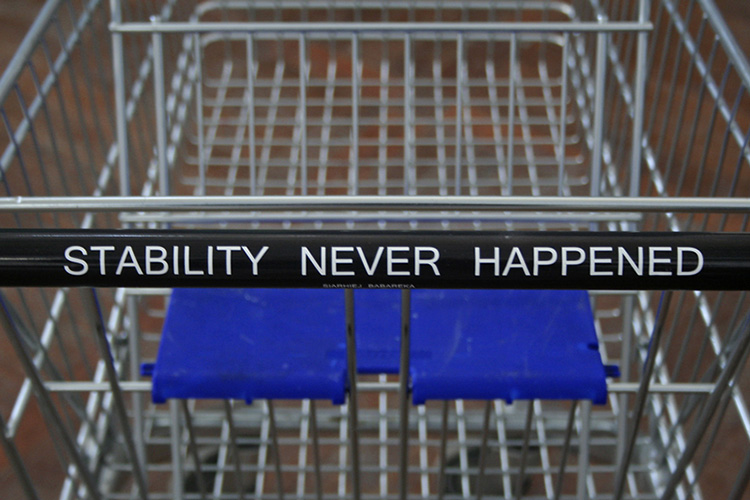
Аўтар: Tania Siacko, 11/01/2015 | ART project
LUDMILA RUSAVA. LIFE AS THE MANIFESTO
OF WILL, OR ART FIRST AND FOREMOST
Women’s names inevitably disappear from the world’s history. Linda Nochlin seems to have explained as early as in the 1970s «why there have been no great women artists» and in what conditions women had to survive in art environment – the distribution of power in the art field and gender-specific representations were made evident. This caused a public and academic debate and led to a number of institutional changes and the transformation of ideas about women (and) feminist art. In particular, we can recall the project «Womanhouse», created by Judy Chicago and Miriam Schapiro in 1972, or The National Museum of Women in the Arts, which started its work in 1981. What concerns our context, since the times of the USSR «the woman question» was solved at the official level, long before these events. Accordingly, a number of problems that were actualized within the western wave – education, family life, relationships with male colleagues – were not topical at all in Belarus (BSSR). Moreover, in the underground circles there was a prevailing opinion that all the people were «equally powerless».
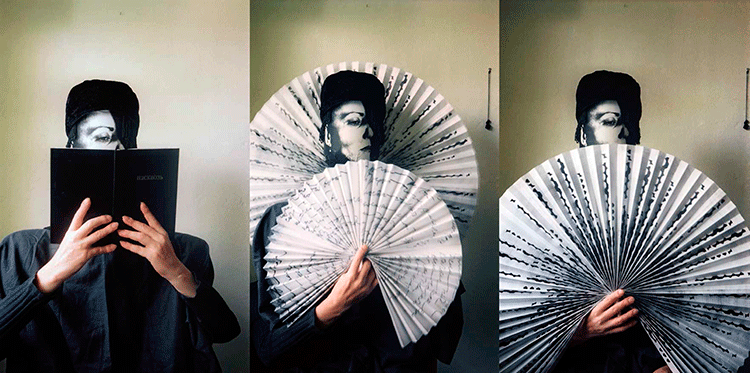
Ludmiła Rusava. Through. 2001 / Photo by S. Ždanovič
The domain of unofficial art was symptomatically asexual, but in fact, represented a classic version of the male community. That is why at the moment a special attention should be paid to a number of blind spots. The current emphasis of gender frameworks is not isolation at all, because, according to Natalya Kameneckaya, women artists have had enough of that ghetto of oblivion and the lack of self-fulfillment. On the contrary, it is an opportunity to grab more nuances, the echo of the personal and the political, in addition to their creative works, as well as to see the story line, which falls out of sight as long as gender optics is not applied to their scrutiny.
The main point, which often escapes both from the mass consciousness and classical art history deals with the (im)possibility of the women’s self-fulfillment in a men’s team. This question is not so often raised in the art field, since there are always «more important things». The confrontation between the Soviet ideology and «art for art’s sake» in our cultural environment was always going ahead of the question «Proletarians of All Countries, Who Washes your Socks?». It is uncomfortable in the first place for female artists themselves. Why is it so? Because the actual thematization of differences presents discomfort in itself, which within the traditional discourse is quite incriminating. In the patriarchal field of art a woman is a muse, a nude, an artist’s wife responsible for his household perceived by him as disgusting for his «creative nature». A woman can play with creativity, but to be a Great Artist herself – God forbid! Not surprisingly, that as soon as it comes to the «real high art», all the differences should be levelled.
In the former Soviet Union these circumstances within the art field started to be comprehended in the late 1980s. The starting point of this process can be marked with the exhibition «Women in Art» held in 1989 in St. Petersburg. In March 1990 in Moscow the first International Exhibition and Conference «ZEN: Woman as a Subject and an Object of Art» was held. Next there came a series of exhibitions, discussions and open feminist projects. It is important to note that women artists happened to act as their organizers and not only as invited participants, whose works would be considered by a dominant «western knowledge».
In Belarus at that time there was silence and discursive ignorance in terms of feminist ideas. However, women artists, of course, did exist and work in their field. And among them there was LUDMIŁA RUSAVA, one of the leading figures of the Belarusian nonconformist art.
THE ABSOLUTE AND IRONY
The main riddle that Ludmiła Rusava left us is that of the transgressive. Moving freely in the area of the intersection of the possible and the impossible, she was constantly building up her own symbolic space, full of content and structural layers. The artist’s semiotic game easily leaves those viewers who got used to decoding meanings too quickly confused. In such a way one can explain quite hasty generalizations like the grandmother of the Belarusian performance or a genuine representative of Suprematism and Malevich’s follower. However, we must understand the incompatibility of these definitions, the discrepancy of the practices diversity. Focusing on this or that direction, Ludmiła Rusava was equally involved in painting, drawing, textiles, performance, poetry and art theory.
The artist’s creative work was concentrated on the intersection of transcendental absolutes and a postmodern game, where the faith in Benjamin’s aura was challenged by the understanding of the impossibility of its realization.
The stage for Ludmiła Rusava was a space for symbolic statements. The basic forms of a cross, a circle, a square – the echo of the primordial, the essence of the visual structure of the first avant-garde were characteristic of her early period. Open colors such as white, red, black were her revolutionary banners, which passed from one performance to another. The artistic language was becoming better articulated, the speech was growing more and more clear – the manifesto was born – from the «thing-in-itself» to the «thing-in-general» in the «thing-in-itself»:
- the reality of white is contrary to the reality of black
2. to balance the contradiction the contrast of the two gives rise to the reality of the third – that of the red
3. but the reality of red is too large – to balance this new controversy, the reality of red calls out the reality of black
4. the power of contradiction at this stage reaches the culmination – the reality of the black is so great that only the call of the reality of the white can balance this contrast
5. a delicate balance of the reality of the white does not satisfy the reality of the red
6. to balance the contradiction there is the reality of the black – and thus a new contradiction of a new round of movement is generated, so the law of contrast works, built on the contradictions of the reality of the rise of color.
Ludmiła Rusava / September 1994, Jafimava
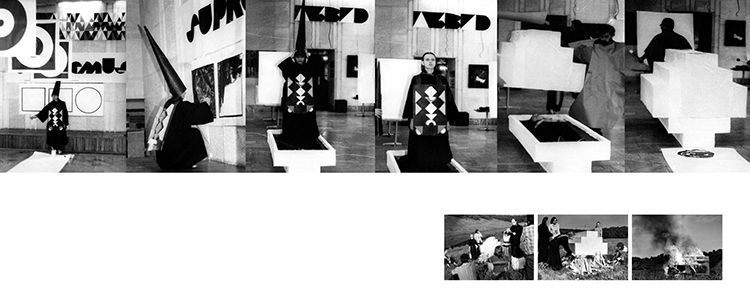
Ludmiła Rusava. Revival of Kazimir (in cooperation with Ihar Kaškurevič). Performance. In the frame of Kazimir Malevich — 110 exhibition, Viciebsk 1988. From I. Kaškurevič’s archives
Textual and ritual seriousness of the «attempts to contemplate and speculate on the movement of colour», as well as other theoretical references, is balanced with a postmodern humor, ironic gestures like the performance Kazimir’s Revival staged in 1988 in Vitebsk or later works entitled I am a Homo Soveticus.
Artistic trips can be considered as separate forms of getting in touch with the world. Here in the first place «the conceptual trip» of 1978 comes to one’s mind. Its outcome took the form of The Black Album – a collage type of work absolutely atypical for the Belarusian art space of that period. Apart from the principle of its creation per se, it the focus on private, personal life that makes it so special, – the fixation of the routine, a living corporeality, a silent attempt to outline «the artist’s own place» and get isolated from the Soviet community. In a sense, all of the mentioned above dealt with the expansion of one’s own freedom boundaries, an attempt to win from the ideological state apparatuses that little which was possible. In other words, it was the development and the enhancement of the dissidents’ private zone where artistic style, repressed values and faith, displaced to the margins could serve as a means of expression.
THE EARTHLY AND THE BORDERLINE SEMIOTICS
In the Soviet non conformist scene the interest in religious metaphysics was a fairly common practice of the resistance to its normativity. One can recall Valentina Kropivnitskaya’s graphic works populated with creatures combining human and animal features on the back ground of temples, Dmitry Plavinsky and his paintings that contain icons’ parts incorporated in them and Lidiya Masterkova who uses in her works abandoned things found in the cathedrals and sewing elements.Here there are also Christian allusions of Modern Baroque presented by Ludmila Yastreb, a nonconformist artist from Odessa.
Faith is that last intimacy which cannot be taken away.
In Ludmiła Rusava’s works religious motives were most vividly present in the 1980s. Her works dating to that period are characterized by cosmogonic nature closely linked to the discourse of faith in its Christian and pagan traditions. Within that period the evangelical cycle was produced, among which there are such works as The Cross, Agony in the Garden, Descent into the Hell and others. Сertainly, it is not only about ritual and church character, but also about the subjective turning point, a shift towards the essence, which is found outside the physical world. We deal with a shaky avant-garde and accidentally face Malevich’s opinion stating that «both religion and art are equally concerned with hygiene and cleanliness and both of them find out that the person having freed from the matter as dirt, lust or depravity, can get this supreme hygiene only through the spirit, inspiration, religion. Religion and art are struggling with the age-old matter as a shameful condition and aim at drawing it into their idea of presenting and necessity».
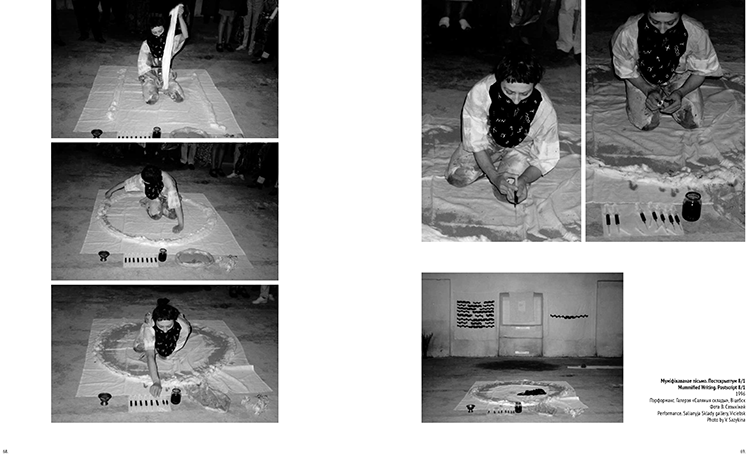
Ludmiła Rusava. Mummified Writing. Postscript 8/1 1996. Performance. Salianyja sklady artistic space, Viciebsk. Photo by V. Sazykina
In the village of Jafimava, following her desire to get rid of the material matter and move towards the absolute a house-studio was created where Ludmiła Rusava together with Ihar Kaškurevič lived and worked for more than ten years. Here numerous group and pair performances were set. All of them combined symbolic actions and individual reactions to the surroundings, namely to the nature. Thus, this was not just a desire to get isolated from the society, but also a wish to create a space functioning according to its own laws and regulations.
Art as a ritual and as a sacred gesture was the concepts frequently encountered in Ludmiła Rusava’s works. Like many other Modernist authors, she aimed at overcoming her experience, completely getting rid of the routine, moving into the domain of artistic practices, which was seen as the sphere of individual actions deprived of any external influence.
These ideas were reflected in the concept of «Free Academy»:
1. Art is not a means, art is the goal…
2. Art is beyond history…
3. Art is beyond politics…
4. Art is not social…
5. Art is self-sufficient…
6. Art does not belong to anyone, except,to a certain extent,to the author…
7. Art is higher than personal ambitions and competition…
Ludmiła Rusava / 07.05.1997
In a certain sense, escapism is determined by social and political conditions, the specificity of place and time, as well as by a wish to escape from the dominating formal regulations. And here it is worth recalling the context: the impermeability of the Soviet ideology, the lack of communication with the world, but by and large, informal art scene of the Soviet republics radicalized already boundless disunity of the Belarusian society. Such circumstances brought back to life the spirit of the Modernist single artist who despite the political component of any action absolutized the creativity or, quoting Ludmiła Rusava’s own words, «loves art, not art in him/herself, let along him/herself in art ...».
THE PLIAGE OF LIFE AND DEATH
In the 1990s the utopian idea of the «special world» of creative practices became apparent. Social and political transformations made a crack in the structural nonconformist culture. «The Empire of Evil» collapsed, the front line was supposed to disappear. Who and why should we resist then? Nevertheless, the concept of «nonconformism» remained deeply rooted in Belarus for long. Underground men and women artists for a while came to light. In comparison with the previous decades one could speak about a significant activization of the environment that began in the second half of the 1980s: the exhibition «1 + 1 + 1 + 1 + 1 + 1 + 1 = 6» (1985), «Fragment-Event’87» (1987), «Perspective» (1987) and others. Pro-modern scene found its place in «The 6th Line» gallery. It was there that in November 1995 Ludmiła Rusava’s solo exhibition «Project-T» was held.
At that time, the artist returned from the countryside house-studio to Minsk. And, obviously, she set new tasks. The character of her performances underwent immediate changes. Alongside with Suprematist allusions and metaphysical rituals, cognitive biographic nature and appeal to the personal narrative appeared. The theme of life and death became evident in them, which created a certain receptive anxiety caused by the artist’s own disease that was developing in that period. It found its way through cognitive motives and actualized the previously mentioned transgressiveness – the desire to overcome, to go beyond the Earth limits, as it was that very transgressiveness that in the given dichotomy represented the darkness, weakness and despair.
When you know that the living do not care about the dead,
When you see that the living are more dead than the dead,
You want to go away… and lie down into the ground
Ludmiła Rusava (1996)
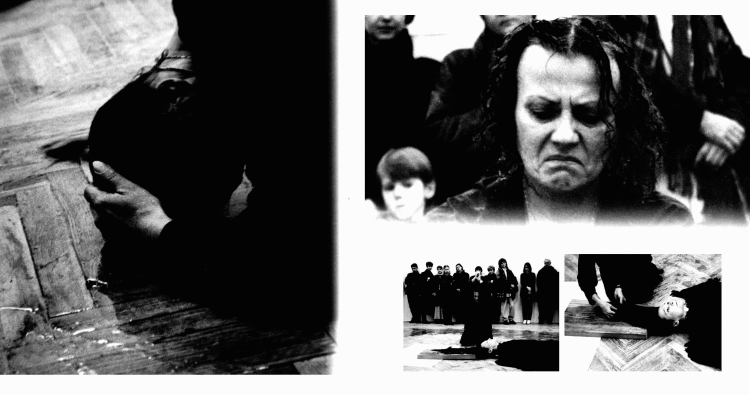
Ludmiła Rusava. After. 1997. Performance. The 6th Line gallery, Minsk. Photo by U. Jurčanka
In the 2000s Ludmiła Rusava actively collaborated with the photographic community. As a result, several significant projects appeared. Playing with Dolls (2000) – «a manifestation of the prolonged existential moment» – provides us with a clear reference to post-structuralism, which was most clearly seen in the last decade. In particular, a series «Green Vision» obviously rhymes with Gilles Deleuze’s concept of rhizome – the appearance of the double pliage. A wound the wideness of which involved us into its open field of questions in an incredible manner:
isn’t it logical to study which is badly seen with the bare eye using a magnifying glass?
Invisible mobility as a visible immobility …
Ludmiła Rusava / Playing with Dolls, 2000
In 1999 Ludmiła Rusava’s linguistic performance appeared – her book All the Way Through. As the author herself claimed, that project was a visualization of the inner rhythms, which were embodied on the verbal (text), personal (cursive) and visual (genographic sign) levels.
The mismatch of her creative intentions and the social reality was becoming more and more obvious. The artist sought as little exposure as possible in Minsk. In 2003 she took part in the Festival of Performance NAVINKI for the last time. At the same time, the project A Place for Dances – 2003 was realized. Later the space narrowed down to the size of her apartment-studio. Ludmiła Rusava continued to do research in the area of the form, developed the phenomenon of effuse spatiality, talked about the blue colour, about being tired of black, red, deadliness.
Despite her disease, Ludmiła Rusava was filled with a specific force and vitality, which not only highlighted a border between being and absence, but in a certain way emphasized the darkness of the local environment.
The artist’s potential and actions were wider than a horizon of possibilities of the Belarusian art field. And if we go back to the issue of a woman artist’s self-fulfillment in a creative environment mentioned above, one can firmly assert that the artist was a radical figure and an impulse for the Belarusian nonconformism starting from the late 1970s. And then, her disappearance from the public space once again demonstrated our mental stupor. In the context of Belarus not only women’s names disappear from the historical narrative, but basically everything that was done by the previous generation. It is «a reset disease» and an inclination for the eternal start that minimize the possibility of communication, continuity, literally burning the field and triggering the discourse of the absence.
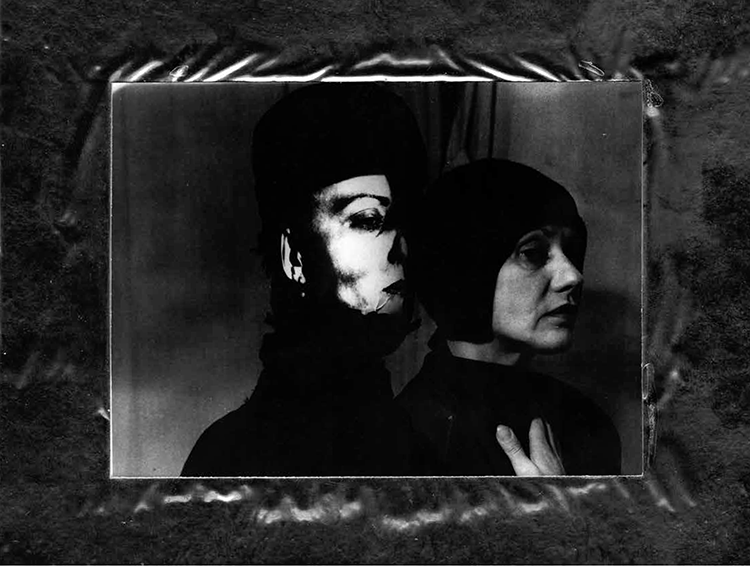
Ludmiła Rusava. Untitled.Collage. From Playing with Dolls series
Ludmiła Rusava is an example of the incredible intensity. The area of her creativity is ruthless and uncompromising, intense and carefully thought through. The artist was always creating around her a field of high tension – some people demonized and feared her, others put her name in the list of the classics, but all recognized the importance of her poignant figure. Through her never-ending game that was full of tragic seriousness and (self) irony, Ludmiła Rusava created a tortuous maze of passages, dialogues that made use of rhythm and rhyme to formulate the manifest of the Belarusian nonconformist art.
…, —
…, — …, —
…, — …, — …, —
…, — …, — …, — …, — …, —
…, — …, — …, — …, — …, — …, — …, — …, ¬-
…, — …, — …, — …, — …, — …, — …, — …, — …, — …, — …, —
…, — …, —
…, — …, — …, — …, — …, — …, — …, — …, — …, — …, — …, —
…, — …, — …, — …, — …, — …, — …, — …, — …, — …, —
…, — …, — …, — …, — …, — …, — …, — …, — …, — …, — …, —
…, — …, — …, — …, — …, — …, — …, — …, — …, — …, —
…, — …, — …, — …, — …, — …, — …, — …, — …, —
…, — …, — …, — …, —
Ludmiła Rusava, 1999
Tania Siacko, visual culture researcher
Special for «pARTisan’s collection» series. Minsk, 2015
Opinions of authors do not always reflect the views of pARTisan. If you note any errors, please contact us right away.



